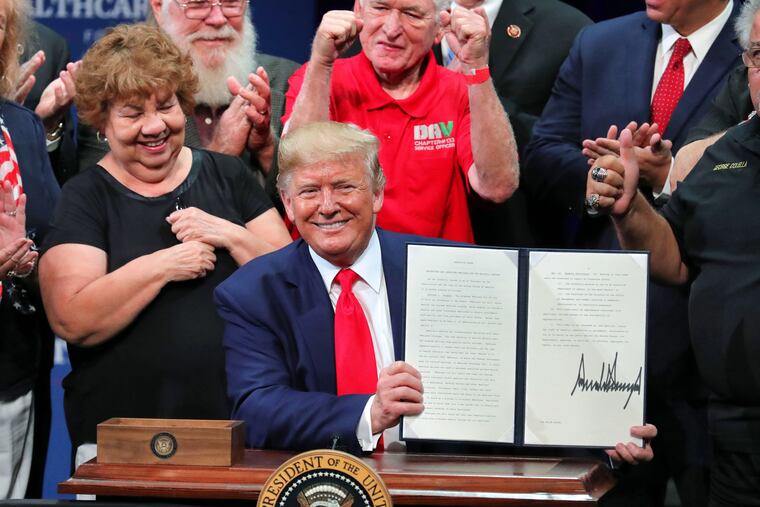Trump is pushing Medicare Advantage for its efficiency. But it’s not that simple.
President Trump is pushing Medicare Advantage as more efficient than traditional Medicare. Analysts say not so fast.

With Medicare’s annual fall enrollment period starting Oct. 15, President Donald Trump has issued an executive order to enhance Medicare Advantage — privately run Medicare plans he described as more efficient and a greater value than traditional Medicare.
People with Medicare Advantage — managed-care plans run by insurance companies — on average are healthier and use fewer health-care services. Yet analysts say that according to the government’s own reporting, the government spends about the same per person, whether they’re covered by traditional Medicare or Medicare Advantage.
How can that be?
Gretchen Jacobson, an associate director of Medicare policy at Kaiser Family Foundation, said the way the government pays for Medicare Advantage members and insufficient reporting requirements makes it hard to determine exactly how efficient the program is.
“It should be a clear-cut answer, but it’s not,” Jacobson said. “There are a lot of things we don’t know.”
What we do know
Medicare is the government health plan that covers seniors and the disabled. Under traditional Medicare, the government pays doctors and hospitals directly for members’ health services. Members pay a Part B premium, which covers medical services, and may buy a Part D drug plan and a supplement plan, called Medigap, to cover other costs, including copays.
Under Medicare Advantage, insurance companies contract with the government to manage members’ care, including by restricting people to specific provider networks. Traditional Medicare members can go to any provider that accepts Medicare.
Medicare Advantage members still pay the Part B premium and may also pay a second premium for the Medicare Advantage plan, which typically includes drug coverage and other benefits not covered by traditional Medicare, such as vision and dental. Those add-ons, and the simplicity of having one plan, are appealing to an increasing number of Americans. About a third of Medicare beneficiaries — some 22 million people — are enrolled in a Medicare Advantage plan.
And these plans are good for the insurance business, too. Insurers earned a gross profit of about $1,600 per Medicare Advantage beneficiary between 2016 and 2018 — double their profit for members in their individual and group health plans — according to an August report by Kaiser Family Foundation, which studies health policy and public health.
Here’s where it gets complicated
A 2015 study published in Health Affairs found that emergency and ambulatory care costs for Medicare Advantage members were as much as 30% less than such costs for people covered by traditional Medicare.
That makes it sound more efficient. But costs may be lower partly because the people who choose Medicare Advantage plans are healthier. Another study found that many high-cost patients who initially enroll in Medicare Advantage move to traditional Medicare, presumably to access more providers.
» READ MORE: You’ve got questions about Medicare’s 2020 fall enrollment period. We’ve got answers.
So why doesn’t the government save on Medicare Advantage? One answer could be that it’s paying too much.
Medicare Advantage plans are paid a set amount per member, with additional payments for people who are sicker — which can lead insurers to overstate the severity of their members’ health problems. Plans overbilled almost $30 billion over the past three years, according to the Department of Health and Human Services.
The Centers for Medicare and Medicaid Services expects enrollment to continue to climb.
Administrative costs are also a lot higher for the private plans than the government-run option. Such costs account for 1% of spending for traditional Medicare. Combined administrative costs for traditional Medicare and private insurers’ administrative costs for Medicare Advantage and drug plans account for 7% of total spending, the New York Times reported last year.
» READ MORE: Medicare’s fall enrollment period is almost here. What’s new for 2020?
So what does Trump’s executive order do?
Trump’s executive order calls for the secretary of health to compose a plan to make Medicare Advantage plans even more flexible, to include telehealth services, and allow members to create Health Savings Accounts to help cover out-of-pocket costs. In 2020, Medicare Advantage plans are already expanding to offer more services, such as transportation to medical appointments and home safety improvements.
The changes could lead to more plan options, which would increase market competition and could help slow the overall growth in Medicare costs, said Matt Eyles, CEO of America’s Health Insurance Plans, a trade association that represents insurance companies.
Will it help consumers?
The trouble, Medicare experts say, is that choosing the right Medicare plan should be a matter of considering one’s own health and finances, not the fringe benefits.
Medicare experts focused on helping people choose the plan that is right for them are concerned about how the Trump administration’s emphasis on Medicare Advantage could affect consumers’ decisions, said Casey Schwarz, senior counsel for the Medicare Rights Center, a patient advocacy organization.
While the fall enrollment period is a time for members to evaluate and change their coverage, most people sign up for Medicare when they turn 65.
“We’re always looking at what’s being put out,” Schwarz said of informational materials. “The need for good education and support for that decision, especially if people are comparing Medicare Advantage to original Medicare with a Medigap plan — that needs to happen as they become eligible, not waiting for fall open enrollment.”